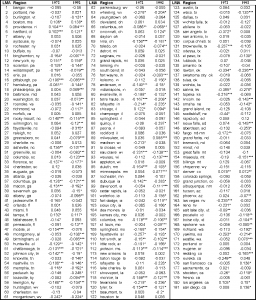As is well known, the LRD only collects wage information on two categories of workers, production and non-production. However, we avoid the usual criticism that dividing workers into production and non-production groups imperfectly classifies them according to skill as our methodology is robust to unobserved differences in regional factor quality. More important for our purposes is that any imperfections in the allocation of workers to production and non-production categories be similar across regions within an industry.
A separate dimension of the data that we exploit in this paper is that of geography. Almost all previous work on trade and geographic heterogeneity within the US has used state data. We prefer to work with groups of counties that correspond more closely with regional labor markets. To this end, we use the Labor Market Areas constructed by the Bureau of Economic Analysis based on common commuting patterns. In the 48 states in our sample there are 181 LMAs. Working with the LMA as the unit of geographic analysis has several advantages in that it allows labor markets to cross state lines and admits the possibility of multiple labor markets within large states.
To run our tests for relative factor price equality, we aggregate the variables into region-industry cells before constructing wagebill ratios.
In Figure 9, we report the results from equation 26 using the US as the base region. For both 1972 and 1992 we easily reject the null hypothesis that all the regions have the same relative wagebills. In 1972, 47 (60) regions have relative wagebills significantly different from the US at the 5 (10) percent level. In 1992, 83 regions reject at the 5 percent level and 97 at the 10 percent level. This is sufficient to reject the single factor price cone hypothesis across regions within the US. In fact, for both years we see regions that reject on each side of zero, i.e. regions with significantly higher relative wagebills and regions with significantly lower relative wagebills suggesting that there are at least three separate factor price regions in the US.
Figure 9: Relative Wagebill Ratios [US=base] (OLS)

